The diagrams and descriptions from Avercheva are easy to implement. Elena has been collecting knitting patterns for a long time and now shares them with her readers. In her examples, you can choose a dense or openwork pattern for any product made with knitting needles.
Necessary tools and materials
Avercheva's knitting patterns and descriptions are provided in the form of ready-made drawings, photo examples with finished fabric and comments for the elements of the work. Rarely does Elena provide advice on selecting tools and materials. Therefore, craftswomen should independently navigate their selection.
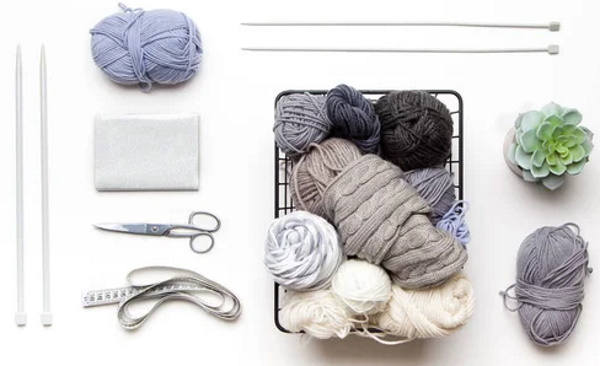
Different knitting needles are used for each type of knitting:
- Straight in the form of 2 knitting needles with limiters to create a straight fabric. Used for knitting simple scarves, clothes.
- Circular ones look like 2 short knitting needles connected by a cord. They are used for knitting hats, collars, sleeves, etc. in a circle. Depending on the size of the product, a long or short cord is chosen.
- Stocking needles are a set of 4-5 knitting needles that are used to create stockings or socks.
- Auxiliary ones are usually short. They are used to make the details of the pattern.
Knitting needles are selected based on their experience or advice from craftsmen. Knitters adhere to the basic rule for selecting knitting needles for yarn: the thickness of the knitting needle should be 1 mm thicker than the thickness of the yarn (knitting needle No. 2 is suitable for yarn 1 mm thick). But there are some nuances here, for example, for complex yarn, such as pile or down, knitting needles are selected 2-3 mm thicker, so that the fabric turns out more interesting.
This tool is also selected for the type of yarn you are going to work with or for a specific product. Too thick needles can make the fabric loose or too tight if you select thin needles. Therefore, yarn manufacturers often leave recommendations for selecting the needle number on the packaging. The needle number corresponds to their thickness in millimeters (for example, a needle with a #3 has a thickness of 3 mm).
In addition to the number, pay attention to the length and composition of the tool. The length depends on the width of the product, and the material is selected to match the type of threads.
| Material | What yarn is it suitable for? |
| Metal | Durable, long lasting. Surface glides well on soft wool and acrylic. |
| Bamboo, wood | Beginner knitters find it easier to use this tool due to the rough surface of the needle. They hold silk and viscose well. Wooden needles break quickly with frequent use. |
| Plastic | Lightweight, flexible and durable needles are suitable for any work. Often used for voluminous and large canvases. |
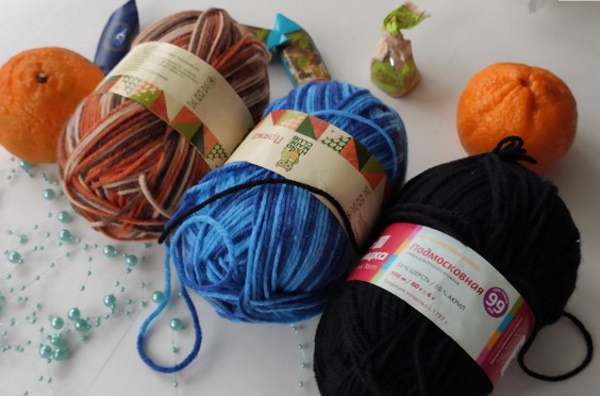
To choose yarn and calculate how much of it is needed for a certain product, pay attention to the conventional thickness. This indicator is on the yarn packaging, and it shows how many meters of thread are in 1 skein or in 100 g of thread. The longer the length is indicated, the thinner the thread of the yarn. The average thickness is about 300 m per 100 g. It is recommended for beginner knitters - it is easy to work with and master loops.
Experienced craftswomen advise choosing the type of yarn for a specific product:
| Yarn type | What product is it suitable for? |
| Melange (mixture of dyed fibers) | Recommended for beginners, as the variegated coloring hides flaws in the work. |
| Natural wool (sheep, goat, camel) | For a warm sweater, scarf. The items are very warm, but can shrink when washed, cause allergies and be prickly to the touch. |
| Wool and acrylic blend | For everyday sweaters (50-70% wool). Items made from thick yarn (less than 100 m per 100 g) can be rough, too bulky and uncomfortable to wear with outerwear. At the same time, thick yarn does not always mean warm if it has little wool pile. |
| Fluffy yarn (with a high content of natural wool) | Mohair does not let the cold through. The yarn may tangle during work, and products made from it may tingle. |
| Cotton and linen | For summer items (dresses, tops, beachwear). The material is of plant origin, absorbs moisture well, is hypoallergenic. The products are comfortable in the heat. |
| Viscose (threads with metallic sheen) | For summer clothing or decorative items. |
| Microfiber (polyester fibers) | Summer clothes are light and soft, they are not hot. The products dry quickly.
Suitable for baby blankets – maintains the required temperature. |
| Acrylic | Hypoallergenic, suitable for children's items (yarn packages often have a corresponding mark - "children's" or "baby"). The products do not prickle, are not damaged by moths and do not shrink when washed. The items are less warm than woolen ones and can become electrified. |

Before the work process, check that the yarn does not shed. To do this, soak the threads in warm water and leave to dry on a white cloth. If the threads shed, the color may begin to come off already in the water or during the drying process.
Schemes with description of works for beginners
Avercheva (knitting patterns, diagrams and descriptions of which are described in detail below, allow you to create a unique item) is a very popular craftswoman among knitters, as she offers a wide selection of designs.
Christmas trees with braids
The knitting pattern in the form of braids intertwined with herringbones is repeated every 14 loops and 30 rows.
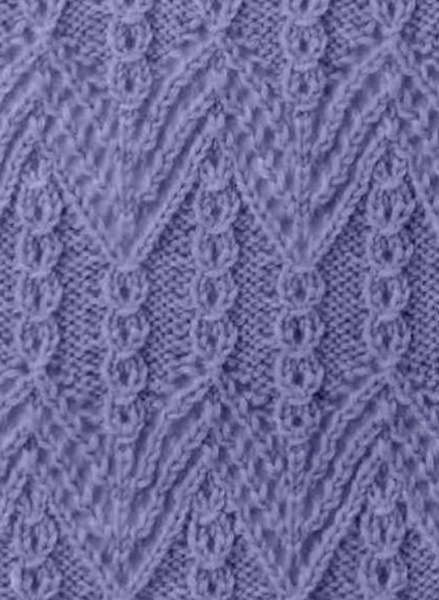
All elements are presented as abbreviations by 1 letter:
- facial – L;
- purl - I;
- 2 knit together right – 2Lvp;
- 2 knit together left – 2Lvl;
- 3 knit together left – 3Lvl;
- yarn over – H;
- 3 loops, crossed front to the right with a yarn over – 3PLN.
The order of execution of 2 front loops with a left tilt:
- remove the 1st loop;
- 2nd knit;
- stretch the 1st through the 2nd.
The order of execution of 2 front loops with a tilt to the right:
- insert the knitting needle into the 2nd loop;
- then to 1st;
- knit both together.
The order of performing 3 loops together with a left tilt:
- remove the 1st loop onto the right knitting needle;
- The next 2 are knitted together;
- pull through the 1st 2 knitted ones.
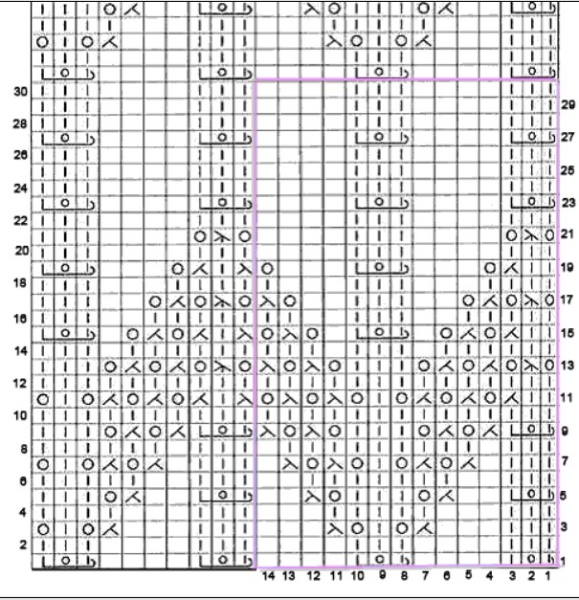
Cast on stitches in the classic manner, the required number of stitches, a multiple of 14.
The pattern is repeated further:
| Row | Elements |
| 1 | 3PNL, 4I, 3PNL, 4I. |
| 2, 20, 22, 24, 26, 28, 30 | 3I, 4L, 3I, 4L. |
| 3 | 3L, 3I, 2Lvp, N, L, N, 2Lvl, 3I. |
| 4 | 3I, 3L, 5I, 3L. |
| 5 | 3PNL, 2I, 2Lvp, N, 3L, N, 2Lvl, 2I. |
| 6 | 3I, 2L, 7I, 2L. |
| 7 | 3L, I, 2Lvl, N, 2Lvl, N, L, N, 2Lvl, N, 2Lvl, I. |
| 8 | 3I, L, 9I, L. |
| 9 | 3PNL, 2Lvl, N, 2Lvl, N, 3L, N, 2Lvl, N, 2Lvl. |
| 10, 12 | All I. |
| 11 | 2L, 2Lvp, H, 2Lvp, H, 2Lvp, H, L, H, 2Lvl, H, 2Lvl, H. |
| 13 | H, 3Lvl, H, 2Lvp, H, 2Lvp, H, 3L, H, 2Lvl, H, 2Lvl. |
| 14 | 6I, L, 3I, L, 3I. |
| 15 | 2L, 2Lvp, N, 2Lvp, N, I, 3PNL, I, N, 2Lvl, N. |
| 16 | 5I, 2L, 3I, 2L, 2I. |
| 17 | H, 3Lvl, H, 2Lvp, H, 2I, 3L, 2I, H, 2Lvl. |
| 18 | 4I, 3L, 3I, 3L, 1I. |
| 19 | 2L, 2Lvp, N, 3I, 3PNL, 3I, N. |
| 21 | H, 3Lvl, H, 4I, 3L, 4I. |
| 23, 27 | 3PNL, 4L, 3PNL, 4L. |
| 25, 29 | 3L, 4I, 3L, 4I. |
Openwork diamonds with wrapping
Avercheva (knitting patterns, diagrams and descriptions of which are given below, can be made in the form of diamonds) is a craftswoman who presented a huge collection of openwork patterns for work. The pattern of volumetric diamonds is 12 loops.
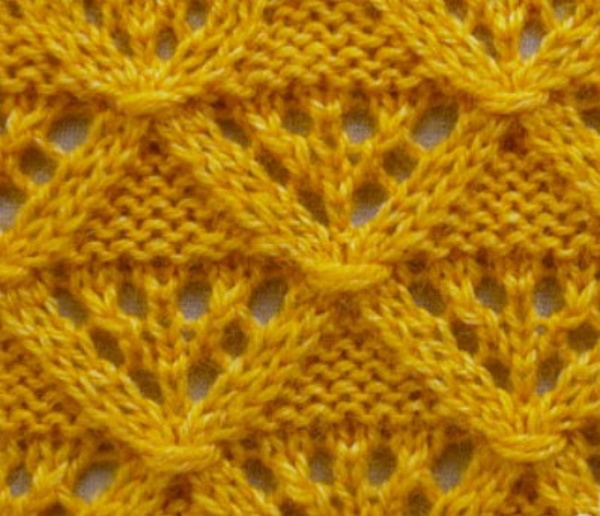
All elements are shown in the description in abbreviations by the first letter:
- facial – L;
- purl - I;
- winding – O;
- yarn over – H;
- 2 loops together to the right – 2Lvp;
- 2 loops together to the left – 2Lvl.
The order of performing the wrapping at the transition points:
- knit 3 stitches;
- they are removed to an additional knitting needle;
- wrap the removed loops with the working thread 5 times (counterclockwise);
- transfer the stitches to the right knitting needle;
- continue knitting.

Odd rows are knitted on the right, even rows on the left. After 16 rows, the pattern is repeated again.
| Row | Elements |
| 1 | 3L, O, 4L. |
| 2 | 4I, 5L, 3I. |
| 3 | 2I, 2Lvp, L, N, L, N, L, 2Lvl, 3I. |
| 4 | 3I, 7L, 2I. |
| 5 | I, 2Lvp, L, N, 3L, N, L, 2Lvl, 2I. |
| 6 | 2I, 9L, I. |
| 7 | 2Lvl, L, N, 2Lvl, N, L, N, 2Lvl, N, L, 2lvl, I. |
| 8 | And, 11L. |
| 9 | 9L, O. |
| 10 | 3L, 7I, 2L. |
| 11 | N, L, 2Lvl, 5I, 2Lvp, L, N, L. |
| 12 | 4L, 5I, 3L. |
| 13 | 2L, N, 2Lvl, 3I, 2Lvp, L, N, 2L. |
| 14 | 5L, 3I, 4L. |
| 15 | N, 2lvl, N, L, 2Lvl, I, 2Lvl, L, N, 2Lvl, N, L. |
| 16 | 6L, I, 5L. |
Openwork chess
Avercheva (knitting patterns, diagrams and descriptions of which are given below with details, can be of different levels of complexity) is a craftswoman who offers to make an openwork pattern in the form of a checkerboard. It is suitable for creating children's or summer clothes. The pattern is repeated every 6 loops.
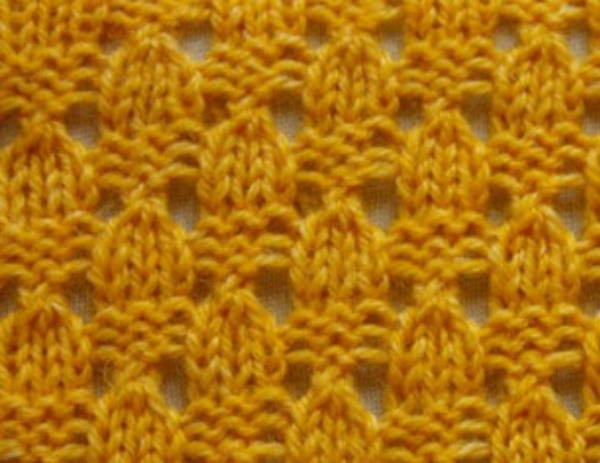
All elements are shown in the description in abbreviations by the first letter:
- facial – L;
- purl - I;
- 3 loops together purlwise – 3VI;
- yarn over – N.
Perform the pattern according to the description, then repeat after 8 rows.

Odd rows are knitted on the right, even rows on the left:
| Row | Elements |
| 1 | 3L, N, 3VI, N. |
| 2, 4 | 3I, 3L. |
| 3 | 3L, 3I. |
| 5 | H, 3VI, H, 3L. |
| 6, 8 | 3L, 3I. |
| 7 | 3I, 3L. |
Openwork zigzags
The openwork zigzag pattern is suitable for creating children's or summer items. Its pattern is repeated every 18 loops.
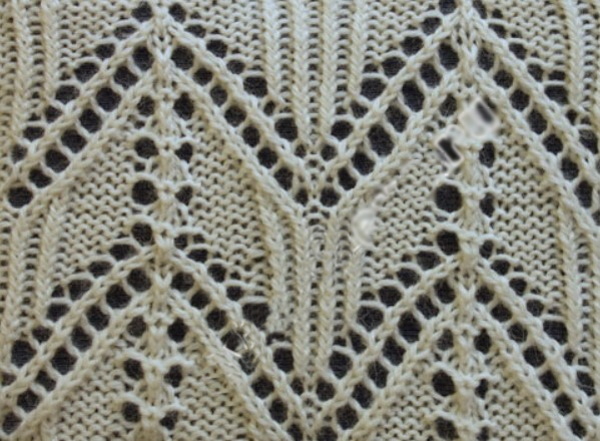
All elements are shown in the description in abbreviations by the first letter:
- facial – L;
- purl - I;
- 2 stitches knit together to the right – 2Lvp;
- 2 loops knit together to the left – 2 lvl;
- yarn over – H;
- 3 knit stitches together – 3Lvm;
- front crossed loop – LS (in even rows as a purl).
The order of making 3 loops, connected together in this pattern:
- remove 2 loops (do not knit);
- 3rd knit;
- insert the left knitting needle into the first 2 loops;
- throw 2 loops onto the 3rd;
- pull out the loop.

The pattern is knitted according to the description and repeated every 20 rows the required number of times. Odd rows are knitted on the right, even rows on the left.
| Row | Elements |
| 1 | I, N, 2Lvl, LS, 4I, 3L, 4I, LS, 2Lvp, N. |
| 2 | 2I, LS, 4L, 3I, 4L, LS, 2I, L. |
| 3 | I, L, N, 2Lvl, 4I, N, 3Lvm, N, 4I, 2Lvp, N, L. |
| 4 | 3I, 11L, 3I, L. |
| 5 | I, N, 2Lvl, N, 2Lvl, 3I, 3L, 3I, 2Lvl, N, 2Lvl, N. |
| 6 | 4I, 3L, 3I, 3L, 4I, L. |
| 7 | L, LS, N, 2Lvl, N, 2Lvl, 2I, N, 3Lvm, N, 2I, 2Lvp, N, 2Lvp, N, LS. |
| 8 | LS, L, 3I, 7L, 3I, L, LS, L. |
| 9 | I, LS, I, N, 2Lvl, N, 2Lvl, I, 3L, I, 2Lvp, N, 2Lvl, N, I, LS. |
| 10 | LS, L, 4I, L, 3I, L, 4I, L, LS, L. |
| 11 | I, LS, I, LS, N, 2Lvl, N, 2Lvl, N, 3Lvm, N, 2Lvp, N, 2Lvp, N, LS, I, LS. |
| 12 | LS, L, LS, L, 3I, 3L, 3I, L, LS, L, LS, L. |
| 13 | I, LS, I, LS, I, N, 2Lvl, N, 2Lvl, L, 2Lvp, N, 2Lvp, N, I, LS, I, LS. |
| 14 | LS, L, LS, 2L, 7I, 2L, LS, L, LS, L. |
| 15 | I, LS, I, LS, 2I, H, 2Lvl, H, 3Lvm, H, 2Lvp, H, 2I, LS, I, LS. |
| 16 | LS, L, LS, 3L, 5I, 3L, LS, L, LS, L. |
| 17 | I, LS, I, LS, 3I, N, 2Lvl, L, 2Lvp, N, 3L, LS, I, LS. |
| 18 | LS, L, LS, 4L, 3I, 4L, LS, L, LS, L. |
| 19 | I, LS, I, LS, 4I, N, 3Lvm, N, 4I, LS, I, LS. |
| 20 | LS, L, LS, 11L, LS, L, LS, L. |
Openwork stripes
Avercheva (knitting patterns, diagrams and descriptions of which are given in detail below, allow you to choose a suitable pattern for your product) is a craftswoman who suggested making an openwork pattern in the form of braids or stripes, suitable for winter and summer decorative items. In this case, only the yarn material is changed. The pattern is repeated every 18 loops (+2).
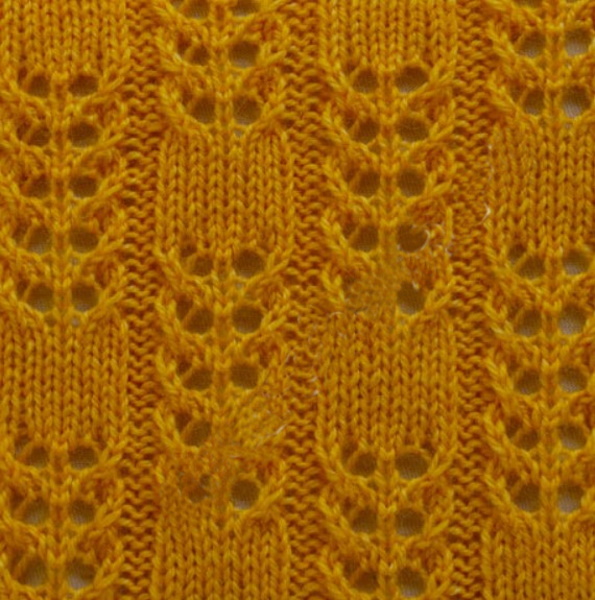
All elements are shown in the description in abbreviations by the first letter:
- facial – L;
- purl - I;
- pass – P;
- yarn over – H;
- 3 loops together front left – 3Lvl;
- 3 loops together front right – 3Lvp.
The order of 3 stitches knitted together to the left in this pattern is:
- remove 1 st onto the right knitting needle (do not knit);
- insert the right knitting needle into the loops on the left knitting needle;
- grab the working thread with the right knitting needle;
- knit through the 3rd and 2nd loops (new loop on the right knitting needle);
- the left needle is inserted into the first removed one;
- place the 1st knitting needle on the knitted one from the 2nd and 3rd;
- pull out the loop.

Perform the pattern according to the description, then repeat after 28 rows. Odd rows are knitted on the right, even rows on the left.
| Row | Elements |
| 1, 5, 9, 13, 17 | 2I, 3Lvp, P, N, L, N, P, 3Lvl, 2I, 7L, 2I. |
| 2, 6, 10, 14, 18 | 2L, 7I, 2L, I, N, 3I, N, I, 2L. |
| 3, 15, 19, 23, 27 | 2I, 7L, 2I, 3Lvp, P, N, L, N, P, 3Lvl, 2I. |
| 4, 16, 20, 24, 28 | 2L, I, N, 3I, N, I, 2L, 7I, 2L. |
| 7, 11, 21, 25 | 2I, 7L, 2I, 7L, 2I. |
| 8, 12, 22, 26 | 2L, 7I, 2L, 7I, 2L. |
Knitting pattern with cords and openwork path
The pattern, despite the large rapport, is simple and accessible for beginner knitters. This pattern with any classic even yarn is used to create hats, scarves, and snoods. The pattern is repeated every 26 loops and 36 rows.

All elements are shown in the description in abbreviations by 1 letter:
- facial – L;
- purl - I;
- 2 loops together to the right – 2Lvp;
- 2 loops together to the left – 2Lvl;
- yarn over – H;
- 4 loops crossed to the left – 4Пвл;
- 4 loops, crossed directions - 4Pvp;
- 3 loops crossed to the right – 3Pvp;
- 3 loops crossed to the left – 3Pvl.
The order of execution of 4 loops, crossed to the left:
- remove 2 loops onto an additional knitting needle (in front of the fabric);
- the next 2 loops are knitted;
- knit the front loops from an additional knitting needle.
The order of execution of 4 loops, crossed to the right:
- remove 2 loops onto an additional knitting needle (behind the fabric);
- the next 2 loops are knitted;
- knit the front loops from an additional knitting needle.
The order of execution of 3 loops, crossed to the right:
- 1 loop is removed onto an additional knitting needle (behind the fabric);
- the next 2 loops are knitted;
- The loop from the additional knitting needle is knitted purlwise.
The order of execution of 3 loops, crossed to the left:
- 2 loops are removed onto an additional knitting needle (in front of the fabric);
- the next loop is knitted purlwise;
- Knit 2 loops from the additional needle as front loops.

Perform the pattern according to the description, then repeat after 36 rows. Odd rows are knitted on the right, even rows on the left.
| Row | Elements |
| 1 | 2I, H, 2Lvl, 2I, 4L, I, 3Pvp, L, 3Pvl, I, 4L, 2I, 2Lvp. |
| 2 | I, 2L, 4I, L, 2I, 3L, 2I, L, 4I, 2L, 2I, 2L. |
| 3 | 2I, 2Lvp, N, 2I, 4L, 3Pvp, 3L, 3Pvl, 4L, 2I, N. |
| 4 | I, 2L, 5I, 5L, 6I, 2L, 2I, 2L. |
| 5 | 2I, H, 2Lvl, 2I, 3L, 3Pvp, 5L, 3Pvl, 3L, 2I, 2Lvp. |
| 6 | I, 2L, 5I, 6L, 5I, 2L, 2I, 2L. |
| 7 | 2I, 2Lvp, N, 2I, 2L, 3Pvp, 7L, 3Pvl, 2 L, 2I, N. |
| 8 | I, 2L, 4I, 9L, 4I, 2L, 2I, 2L. |
| 9 | 2I, H, 2Lvl, 2I, 4Pvl, 9L, 4Pvp, 2I, 2Lvp. |
| 10 | I, 2L, 4I, 9L, 4I, 2L, 4I, 2L. |
| 11 | 2I, 2Lvp, N, 2I, 2L, 3Pvl, 7L, 3Pvp, 2L, 2I, N. |
| 12 | I, 2L, 5I, 7L, 5I, 2L, 2I, 2L. |
| 13 | 2I, H, 2Lvl, 2I, 3L, 3Pvl, 5L, 3Pvp, 3L, 2I, 2Lvp. |
| 14 | 2I, 2L, 6I, 5L, 6I, 2L, 2I, 2L. |
| 15 | 2I, N, 2Lvl, 2I, 4L, 3Pvl, 3L, 3Pvp, 4L, 2I, N. |
| 16 | I, 2L, 4I, L, 2I, 6L, 4I, 2L, 2I, 2L. |
| 17 | 2I, H, 2Lvl, 2I, 4L, I, 3Pvl, L, 3Pvp, I, 4L, 2I, 2Lvp. |
| 18 | I, 2L, 4I, 2L, 2I, L, 2I, 2L, 4I, 2L, 2I, 2L. |
| 19 | I, L, 3Pvl, I, 4L, 2I, 2Lvp, N, I, N, 2lvl, 2I, 4L, I, 3Pvp. |
| 20 | 2I, L, 4I, 2L, 2I, L, 2I, 2L, 4I, L, 2I, 3L. |
| 21 | I, 2L, 3Pvl, 4L, 2I, N, 2Lvl, I, 2Lvp, N, 2I, 4L 3Pvp. |
| 22 | L, 6I, 2L, 2I, L, 2I, 2L, 4I, 6L. |
| 23 | I, 3L, 3Pvl, 3L, 2I, 2Lvp, N, I, N, 2Lvl, 2I, 3L, 3Pvp, 3L. |
| 24 | 2L, 5I, 2L, 2I, L, 2I, 2L, 5I, 5L. |
| 25 | I, 4L, 3Pvp, 2L, 2I, H, 2Lvl, I, 2Lvp, H, 2I, 2L, 3Pvp, 2L. |
| 26 | 3L, 4I, 2L, 2I, L, 2I, 2L, 4I, 6L. |
| 27 | I, 5L, 4Pvp, 2I, 2Lvp, H, I, H, 2Lvl, 2I, 4Pvl, 3L. |
| 28 | 3L, 4I, 2L, 2I, L, 2I, 2L, 4I, 6L. |
| 29 | I, 4L, 3Pvp, 2L, 2I, H, 2Lvl, I, 2Lvp, H, 2I, 2L, 2Pvl, 2L. |
| 30 | 2L, 5I, 2L, 2I, L, 2I, 2L, 5I, 5L. |
| 31 | I, 3L, 3Pvl, 3L, 2I, 2Lvp, N, I, N, 2Lvl, 2I, 3L, 3Lvl, L. |
| 32 | L, 6I, 2L, 2I, L, 2I, 2L, 6I, 4L. |
| 33 | I, 2L, 3Pvp, 4L, 2I, N, 2Lvl, I, 2Lvp, N, 2I, 4L, 3Ppl. |
| 34 | 2I, L, 4I, 2L, 2I, L, 2I, 2L, 4I, L, 2I, 3L. |
| 35 | I, L, 3pvp, I, 4L, 2I, 2Lvp, N, I, N, 2Lvp, 2I, 4L, I, 3Pvl. |
| 36 | I, 2L, 4I, 2L, 2I, L, 2I, 2L, 4I, 2L, 2I, 2L. |
Secrets for Beginners
Scroll:
- Before starting work, carefully read the diagram and all descriptions of the work process, since the designations may differ. If this is not taken into account before starting knitting, the fabric will have to be redone.
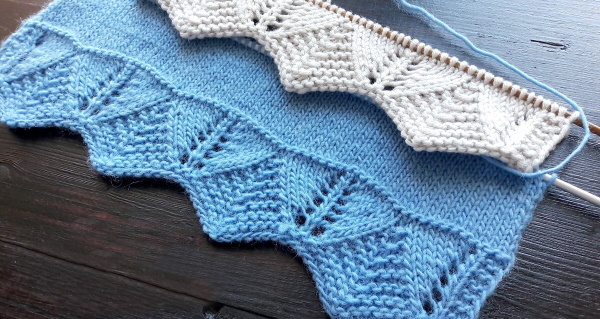
- If the instructions indicate several recommendations for different sizes at once, you can highlight the desired parameter with a marker or in another way. This will allow you not to be distracted by unnecessary information during the work process.
- To calculate the required number of loops and rows to complete the product, first knit a small sample measuring 10*10 cm and calculate how many of these squares will be needed in total. Compare the number of loops with the number indicated in the pattern. If there are more, then knit tighter or use knitting needles thinner by 1 number. If there are fewer loops in the sample than in the pattern, then try to knit more freely or use thicker knitting needles.
- To account for changes in the dimensions of cotton yarn, a sample of these threads is knitted in water at the maximum value permitted for this yarn. Then it is determined how much the material has shrunk.
- If you are knitting a product for the first time, then choose a looser silhouette. Models of a more complex style are made when you have trained yourself to make different loops.
- If you are making a children's item on which you plan to lengthen the sleeves, then knit from top to bottom. Then all increases become decreases and vice versa. When necessary, the closed loops are unraveled and the sleeve is lengthened by the required number of rows.
- To mark certain areas of work (places of decrease or increase, transitions between rows, etc.), special marking rings of different sizes are used, which can be removed at the end of the work without damaging the fabric.
- To prevent loops from slipping during work or breaks, use needle tips, which can be purchased in craft stores or made yourself from scrap materials.
- Count rows in complex patterns using a special counter.
- Make the fishing line on circular knitting needles softer by placing it in boiling water for a few minutes.
- When working with dark yarn, place a light fabric under the fabric so that the rows and loops are easier to distinguish.
- To prevent your hands from getting tired while working, use circular knitting needles.
- To hide the ends of the threads at the end of knitting, use a hook as an auxiliary tool.
- To connect the ends of thin yarn unnoticeably, thread one end of it into a needle and pull it through the other end of the thread by 5 cm. Only a small tail remains visible from each end, which is cut off at the end of the work.
Avercheva's knitting patterns and descriptions sometimes include tips and recommendations on how to simplify the work, select yarn, etc. Knitters may find it easier to make a product with any pattern if they follow a few simple tips from other experienced craftswomen.
Video about Avercheva knitting patterns
Simple knitting patterns. Pattern "Pistachios":
